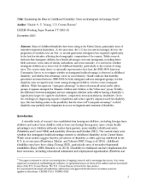Examining the Rise in Childhood Disability: Does an Immigrant Advantage Exist?
Examining the Rise in Childhood Disability: Does an Immigrant Advantage Exist?
Introduction
While research indicates that immigrant children have health advantages over non-immigrants, including better birth outcomes, lower rates of obesity and asthma, and lower mortality, it is not known whether immigrant children are at lower risk of childhood disability, particularly in the context of rising rates. The current study draws on nationally representative data from the 2008-2019 American Community Survey to investigate whether an immigrant health advantage is observed in childhood disability, and whether this advantage varies by race/ethnicity. Results indicate that disability prevalence increased between 2008-2019 for both immigrant and non-immigrant groups, but that disability rates are significantly lower among immigrant children, relative to non-immigrant children. While this apparent “immigrant advantage” is observed across all racial and/or ethnic groups, it appears strongest for Hispanic children and children in the “other race” group. Notably, the difference between immigrant and non-immigrant children in the odds of having a disability is significantly larger for cognitive disabilities, compared to sensory/ambulatory disabilities. Given the challenges in diagnosing cognitive disabilities and culture-specific stigma toward this disability type, this last finding points to the possibility that the observed “immigrant advantage” in child disability may partially belie disparities in access to diagnosis and treatment of disability.




